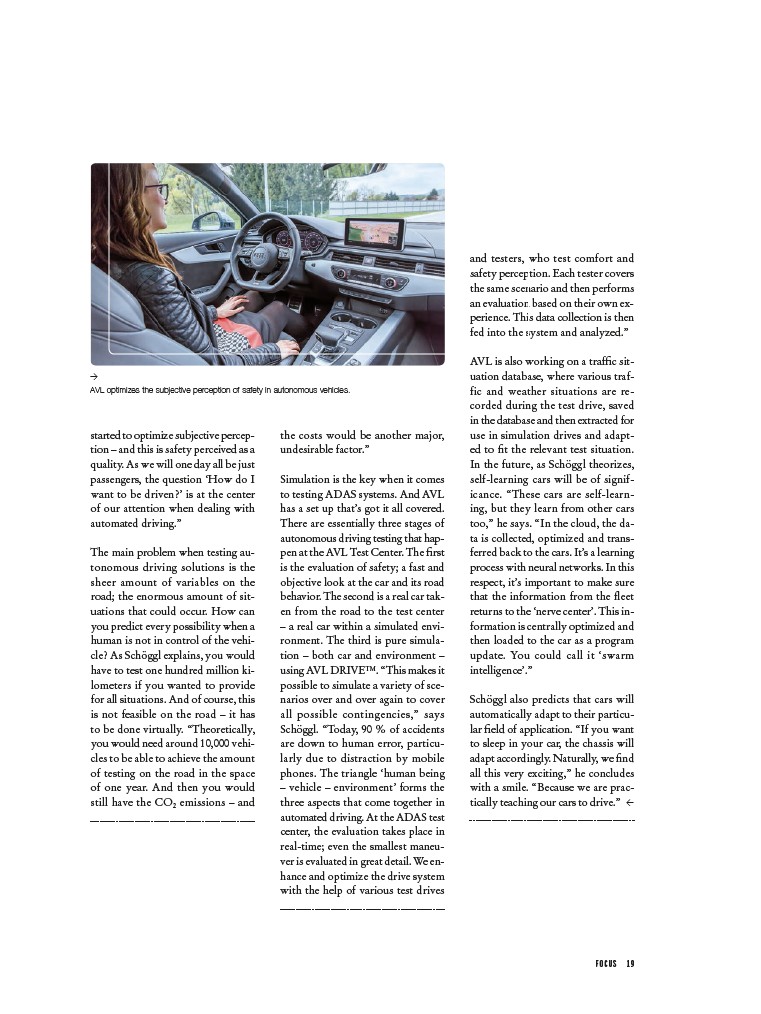
F O C U S 1 9
started to optimize subjective perception
– and this is safety perceived as a
quality. As we will one day all be just
passengers, the question ‘How do I
want to be driven?’ is at the center
of our attention when dealing with
automated
driving.”
The main problem when testing autonomous
driving solutions is the
sheer amount of variables on the
road; the enormous amount of situations
that could occur. How can
you predict every possibility when a
human is not in control of the vehicle?
As Schöggl explains, you would
have to test one hundred million kilometers
if you wanted to provide
for all situations. And of course, this
is not feasible on the road – it has
to be done virtually. “Theoretically,
you would need around 10,000 vehicles
to be able to achieve the amount
of testing on the road in the space
of one year. And then you would
still have the CO2 emissions – and
the costs would be another major,
undesirable factor.”
Simulation is the key when it comes
to testing ADAS systems. And AVL
has a set up that’s got it all covered.
There are essentially three stages of
autonomous driving testing that happen
at the AVL Test Center. The first
is the evaluation of safety; a fast and
objective look at the car and its road
behavior. The second is a real car taken
from the road to the test center
– a real car within a simulated environment.
The third is pure simulation
– both car and environment –
using AVL DRIVE™. “This makes it
possible to simulate a variety of scenarios
over and over again to cover
all possible contingencies,” says
Schöggl. “Today, 90 % of accidents
are down to human error, particularly
due to distraction by mobile
phones. The triangle ‘human being
– vehicle – environment’ forms the
three aspects that come together in
automated driving. At the ADAS test
center, the evaluation takes place in
real-time; even the smallest maneuver
is evaluated in great detail. We enhance
and optimize the drive system
with the help of various test drives
and testers, who test comfort and
safety perception. Each tester covers
the same scenario and then performs
an evaluation based on their own experience.
This data collection is then
fed into the system and analyzed.”
AVL is also working on a traffic situation
database, where various traffic
and weather situations are recorded
during the test drive, saved
in the database and then extracted for
use in simulation drives and adapted
to fit the relevant test situation.
In the future, as Schöggl theorizes,
self-learning cars will be of significance.
“These cars are self-learning,
but they learn from other cars
too,” he says. “In the cloud, the data
is collected, optimized and transferred
back to the cars. It’s a learning
process with neural networks. In this
respect, it’s important to make sure
that the information from the fleet
returns to the ‘nerve center’. This information
is centrally optimized and
then loaded to the car as a program
update. You could call it ‘swarm
intelligence’.”
Schöggl also predicts that cars will
automatically adapt to their particular
field of application. “If you want
to sleep in your car, the chassis will
adapt accordingly. Naturally, we find
all this very exciting,” he concludes
with a smile. “Because we are practically
teaching our cars to drive.” <
>
AVL optimizes the subjective perception of safety in autonomous vehicles.